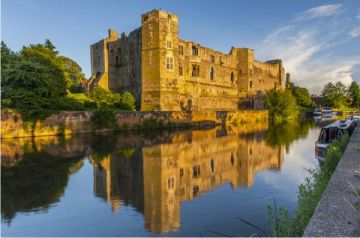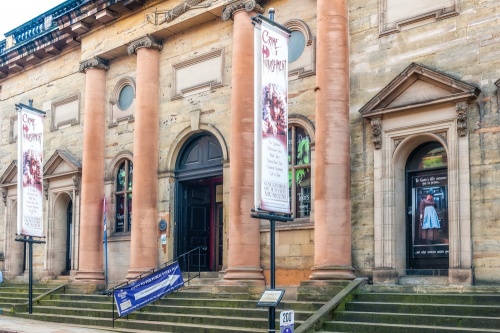
Occupying one side of Nottingham's historic Lace Market is Shire Hall and County Gaol, built on a site used for the administration of justice since the 14th century. Today the Shire Hall and the neighbouring Edwardian police station have been transformed into the largest museum in Britain dedicated to law, justice, crime and punishment. Visitors can explore the historic courtroom and the original prison cells.
The museum has a collection of over 40,000 objects linked to the administration of justice and punishment of criminals.
Among the fascinating objects on display is the door of Oscar Wilde's prison cell from Reading Gaol, evidence gathered in the Great Train Robbery (including the Monopoly set the gang played while waiting for the manhunt to die down), and the prisoner's dock from the Bow Street Magistrates Court in London.
Famous prisoners to stand in the dock included Oscar Wilde, Dr Crippen, and the infamous Kray brothers. Suffragette Emmeline Pankhurst stood in the dock after her arrest, as did her daughter Christabel, and, more recently, the novelist and politician Jeffrey Archer
Some of the exhibits require a strong stomach! Included in them is the bathtub from the 'brides in the bath' murders, for which George Joseph Smith was hanged in 1915. You can also see gibbet irons, a Georgian 'birching stool', and the equipment used to force-feed suffragettes and conscientious objectors who were on hunger strikes. Prisoners who refused to complete arduous manual labour might be put on a severely restricted diet, and you can see the set of measures used to dole out their small portions of food.
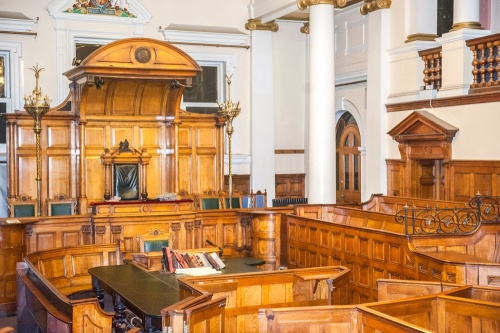
The Last Working Gallows in Britain
In a yard behind the gaol is a gallows, set up on the same spot where criminals were hanged after public executions were banned. The gallows comes from Wandsworth prison, where it was preserved in full working order as late as 1990.
Though the death penalty was abolished for murder in 1965 (1973 in Northern Ireland) it remained a theoretical possibility for treason, piracy with violence and mutiny in the armed forces. For that reason, the Wandsworth gallows was kept in working order and regularly tested in case it was ever needed. Thankfully, it wasn't.
Prisoners executed on these gallows include the WWII Nazi radio broadcaster William Joyce (popularly known as Lord Haw-Haw) and the burglar Derek Bentley (Bentley was later posthumously pardoned).
Visitors can climb up the steps and stand on the trap door above the fatal 12-foot drop. In a glass cabinet near the gallows is a partly-drunk bottle of whisky, a reminder that condemned prisoners were offered a tot of brandy or whisky to steady their nerves for their last moments on earth.
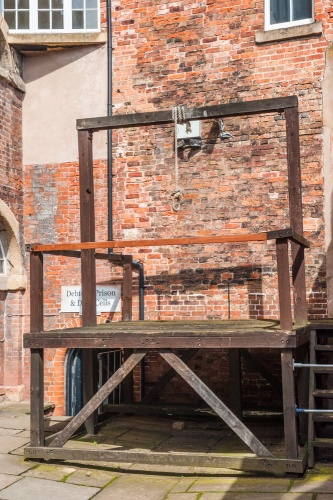
And on the theme of executions, you can see the black box used a travelling kit by hangmen, who often had to travel around the country to perform executions. Included in the kit are a sandbag, ropes, a block and tackle, measuring rod and restraining straps.
One of the highlights of a visit to the National Museum of Justice is the beautifully restored wood-panelled courtroom. You can ascend the stairs from holding cells below the courtroom and emerge into the dock, looking up at public galleries and the imposing dais where the judges sit.
The courtroom is the setting for regular reenactments of both famous and little-known trials. When we visited we could listen to a recording of the trial of Daniel Diggle, a young man accused of breaking a knitting frame during the early 19th-century Luddite riots. The recording is based on the records of a real case; Diggle was found guilty of shooting a woollen manufacturer in 1817 and executed outside Shire Hall.
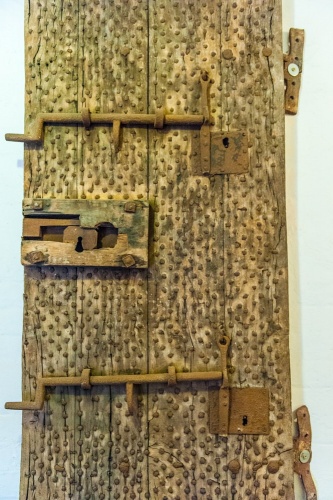
History
Written records suggest that Shire Hall was used by the powerful Sheriff of Nottingham as early as 1375. Indeed, the site was often known as Sheriff's Hall. The Sheriff's main duties were to collect taxes and administer justice. We do know that there were gaol cells on this site since at least 1449.
Those medieval buildings were in dire need to repair by 1724. During a court case in March of that year the courtroom floor collapsed, sending the prisoner, jury, solicitors and members of the public plummeting into the cellars below, while the startled judge could only watch on.
The Hall was finally rebuilt in 1769 to a design by James Gandon of London, at a cost of some £2,500. The new building had an iron palisade in front to help keep unruly crowds at bay during public executions.
Prison Reformer John Howard visited Shire Hall in 1777 and was generally pleased to see that 'this gaol has been lately repainted and much improved'. He was less impressed, however, with the fact that notices warning against the dangers of strong liquor had not been posted.
Howard would not have given such a favourable report in 1878; the prison was closed in that year, in part due to the dreadful conditions. The courtroom, however, remained in use until 1991 when the new Crown Court was built. The last cases to be heard in Shire Hall were offences arising from the 1984-85 miners strike.
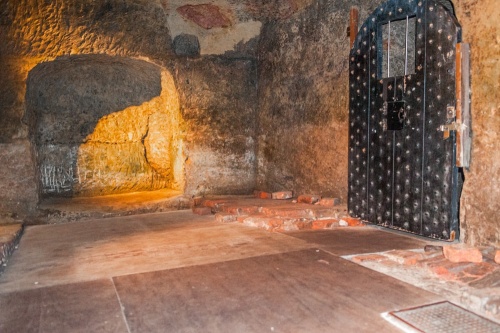
Beside Shire Hall is the former High Pavement Police Station, built in 1847 and remodelled in 1905. The station was used by the Nottinghamshire Count Police until 1954 then as a divisional headquarters building until 1985. The cells continued to be used as holding cells for another 2 years.
Ghosts
Perhaps not surprisingly, Shire Hall has been the scene of reported ghostly activity. Terrifying groans and screams have been heard in the courtroom area, and 3 ghosts are said to haunt the entrance hall. Dark figures have been sighted in the prison area, and visitors have reported being touched when there is no one there. Worst of all is the chapel and cave area, the scene of frequent poltergeist activity.
Now, having said all that, we explored the Museum from top to bottom and didn't experience anything out of the ordinary at all - though the execution area behind the gaol was not a place we cared to linger, but that had nothing to do with ghosts!
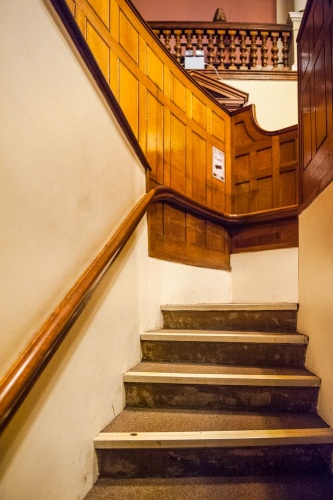
in the courtroom
The Museum does much more than just exhibit historical items; it offers a large array of historical experiences aimed at bringing the history of justice into the public eye. The Museum holds reenactments of famous trials and public debates on social justice issues. Though these events are often geared to students, they are usually open to the general public as well.
The National Justice Museum also operates the City of Caves attraction, allowing visitors to explore the caves that lie under most of Nottingham's town centre. The caves have been used since at least the Dark Ages and there are more caves discovered on a regular basis.
About National Justice Museum
Address: High Pavement,
Nottingham,
Nottinghamshire,
England, NG1 1HN
Attraction Type: Museum
Location: On the Lace Market near St Mary's Church. No on-site parking.
Website: National Justice Museum
Email: info@nationaljusticemuseum.org.uk
Location
map
OS: SK575395
Photo Credit: David Ross and Britain Express
HERITAGE
 We've 'tagged' this attraction information to help you find related historic attractions and learn more about major time periods mentioned.
We've 'tagged' this attraction information to help you find related historic attractions and learn more about major time periods mentioned.
Find other attractions tagged with:
NEARBY HISTORIC ATTRACTIONS
Heritage Rated from 1- 5 (low to exceptional) on historic interest
Nottingham, St Mary's Church - 0.1 miles (Historic Church) ![]()
Nottingham, St Peter's Church - 0.2 miles (Historic Church) ![]()
Nottingham Castle - 0.4 miles (Castle) ![]()
Robin Hood Statue - 0.4 miles (Historic Building) ![]()
Museum of Nottingham Life at Brewhouse Yard - 0.4 miles (Museum) ![]()
Wollaton Hall and Natural History Museum - 2.7 miles (Historic House) ![]()
Holme Pierrepont Hall - 3.3 miles (Historic House) ![]()
Strelley, All Saints Church - 4.6 miles (Historic Church) ![]()
Nearest Holiday Cottages to National Justice Museum:
Ilkeston, Derbyshire
Sleeps: 4
Stay from: £402 - 1241
More self catering near National Justice Museum



